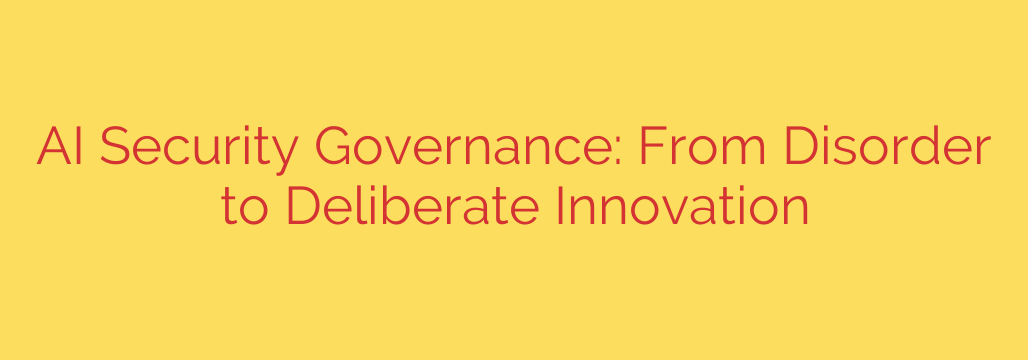
From Chaos to Control: A Practical Guide to AI Security Governance
The rapid adoption of artificial intelligence is no longer a future concept; it’s a present-day reality. From automating simple tasks to powering complex analytics, organizations are in a gold rush to integrate AI and Large Language Models (LLMs) into their operations. However, this rush often overlooks a critical foundation: security. Without a deliberate strategy, companies are deploying powerful tools in a state of disorder, exposing themselves to a new and dangerous class of threats.
Moving from this chaotic adoption to deliberate, secure innovation requires a robust AI security governance framework. This isn’t about stifling progress; it’s about building the guardrails necessary to innovate safely and sustainably.
Understanding the New AI Threat Landscape
Traditional cybersecurity focuses on protecting networks, servers, and endpoints. AI security, however, introduces a new attack surface: the model itself. Malicious actors are no longer just trying to breach your firewall; they are trying to manipulate the logic, data, and outputs of your AI systems.
Understanding these unique threats is the first step toward effective governance. Key vulnerabilities include:
- Data Poisoning: This attack corrupts the AI’s training data. By injecting subtle, malicious information, an attacker can create hidden backdoors or biases in the model, causing it to fail or produce harmful results in specific situations.
- Model Evasion: Attackers craft inputs that are designed to deceive the model. For example, a slightly altered image that is imperceptible to a human could be classified incorrectly by an AI, bypassing security filters or causing an autonomous vehicle to misinterpret a stop sign.
- Prompt Injection: A critical threat for LLMs, prompt injection involves tricking the model into ignoring its original instructions and following the attacker’s commands instead. This can be used to leak sensitive data, generate inappropriate content, or execute harmful actions.
- Model Extraction and Theft: Your AI models are valuable intellectual property. Attackers can use sophisticated queries to reconstruct the model or extract the sensitive proprietary data it was trained on, effectively stealing your competitive advantage.
Building Your AI Security Governance Framework
A strong governance framework transforms your approach from reactive to proactive. It provides the structure, policies, and controls needed to manage AI risks across the organization. Here are the essential pillars for building one.
1. Establish Clear Ownership and Accountability
AI security is not just an IT problem. An effective governance strategy requires a cross-functional team with clear roles and responsibilities.
- Form an AI Governance Committee: This group should include leaders from security, legal, data science, IT, and key business units. Their mandate is to define the organization’s AI strategy, risk appetite, and ethical guidelines.
- Assign Model Owners: Every AI model or system in use must have a designated owner who is accountable for its performance, security, and compliance throughout its lifecycle.
2. Develop a Comprehensive AI Use and Risk Policy
Not all AI applications carry the same level of risk. Your governance policy must define what is acceptable and classify systems based on their potential impact.
- Create an AI Inventory: You cannot protect what you don’t know you have. The first step is to catalogue every AI and LLM application currently in use or development, including third-party tools and APIs used by employees.
- Classify by Risk: Categorize each AI system (e.g., low, medium, high risk). An internal tool for summarizing documents is low-risk, while an AI used for medical diagnoses or financial trading is high-risk. This classification will determine the level of security scrutiny required.
- Define Acceptable Use: Clearly outline how AI can and cannot be used. For instance, policies should prohibit uploading sensitive company or customer data to public, third-party LLMs.
3. Secure the AI Supply Chain
Modern AI systems are rarely built entirely from scratch. They rely on a complex supply chain of open-source models, pre-trained algorithms, third-party APIs, and vast datasets. Each link in this chain is a potential point of failure.
- Vet Third-Party Models and Data: Before integrating any external AI component, you must thoroughly vet its source, security posture, and potential embedded vulnerabilities.
- Demand a “Bill of Materials”: Just as with software (SBOM), demand an AI Bill of Materials (AIBOM) that details the components, data sources, and licenses used to build the model. This transparency is crucial for risk assessment.
4. Implement Technical Controls and Continuous Monitoring
Policy is meaningless without enforcement. Technical controls are essential for securing the AI development lifecycle and monitoring models in production.
- AI Red Teaming: Proactively attack your own models to find vulnerabilities before malicious actors do. This includes stress-testing for prompt injection, evasion, and data poisoning scenarios.
- Continuous Monitoring: AI models can “drift” over time, becoming less accurate or more vulnerable. Implement continuous monitoring to track model performance, detect anomalies, and identify suspicious input patterns that could signal an attack.
- Secure Development Practices: Train your developers on secure AI coding practices. The security of an AI model begins with the code and data used to create it.
The Path to Deliberate Innovation
The potential of AI is immense, but realizing that potential depends on our ability to trust these systems. A well-structured AI security governance framework is the mechanism for building that trust. It provides the clarity, control, and confidence needed to move beyond chaotic experimentation.
By establishing clear ownership, defining risk-based policies, securing the supply chain, and implementing robust technical controls, you transform AI security from an afterthought into a strategic enabler. This deliberate approach doesn’t slow down innovation—it ensures that your organization’s journey into the AI frontier is both ambitious and secure.
Source: https://www.helpnetsecurity.com/2025/08/14/ai-security-governance/








